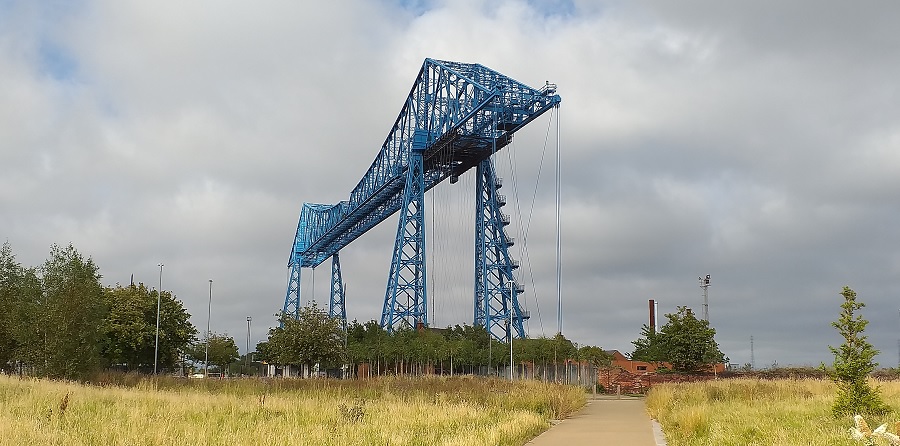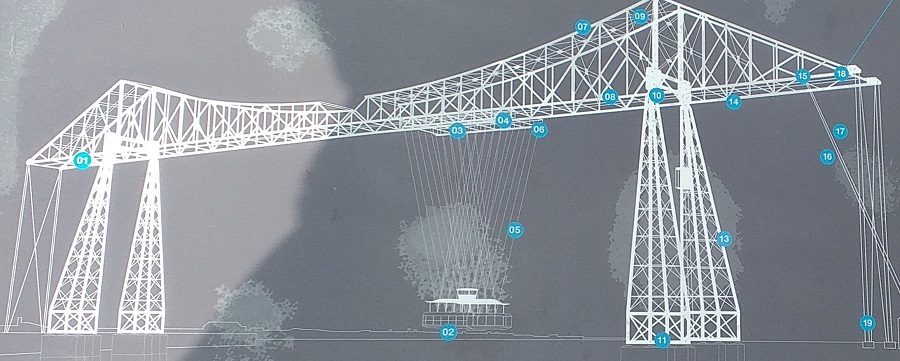The Middlesbrough Transporter bridge is an impressive Grade II* listed structure and local landmark that towers above the River Tees. More commonly known as the Tees Transporter Bridge, it connects the town of Middlesbrough with Port Clarence, on the opposite bank of the Tees. [MAP]
It’s one of only three working Transporter Bridges in Britain and, with a length of 851ft (259.3m), the Middlesbrough Transporter Bridge holds the distinction of being the longest working transporter bridge in the world.
Transporter bridges are rare. They always have been. Only 24 were built in the entire world. Six of them were in the UK and, of the 24 bridges, only 12 are still in regular use. If you are in Teesside, it’s worth making time to go and have a closer look at the Middlesbrough Transporter Bridge or taking a trip across the water in the gondola that makes the journey possible.
It’s also possible to take a guided trip to the top of the bridge as part of the Transporter Bridge Visitor Experience.
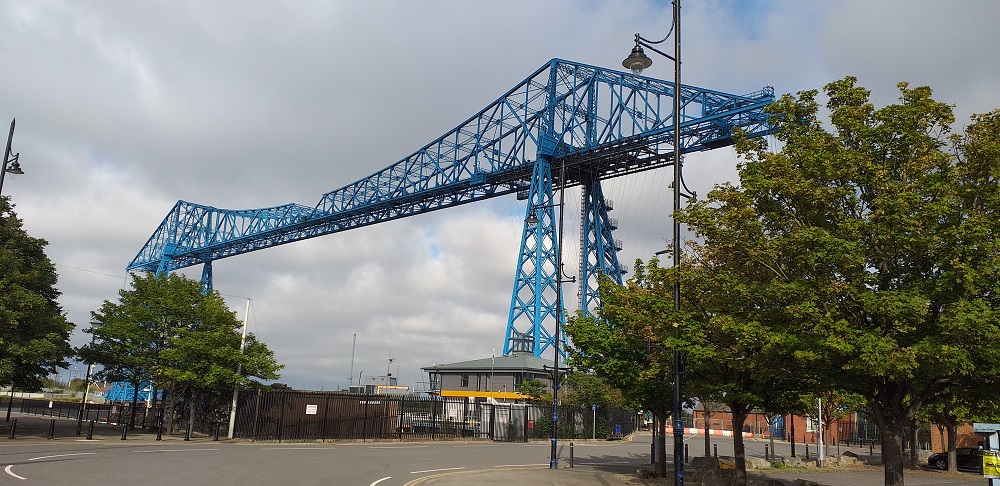
What Is a Transporter Bridge?
Sometimes called a ferry bridge, a transporter bridge differs from other types of bridges in several ways. First of all, this type of bridge is always tall. Secondly, transporter bridges always provide a means of crossing a river but its the way the bridge gets people across the water that is particularly unusual.
Normal bridges allow roads to continue across rivers. That’s not how transporter bridges work. Instead, they carry a small section of the road from one side of the river bank to the other. It’s a drive on-drive off scenario that operates a little like a ferry.
The moving section dangles from steel cables that are attached to a carriage at the top of the bridge, high above the water. The carriage is pulled from one side of the river to the other by thick steel cables. It’s a slow but efficient way to “transport” pedestrians and traffic across a river.
The people running the Middlesbrough Transporter Bridge call the moving section a “gondola” and it’s as good a name as any.
Unless you are already familiar with transporter bridges, you will probably be wondering why anyone would choose to build this type of bridge in preference to another. The reason is pretty simple. Transporter bridges are so high that ships with tall masts can pass beneath them easily. In 1911, when the transporter bridge was opened, there would have been a lot of traffic of this nature travelling up and down the Tees.
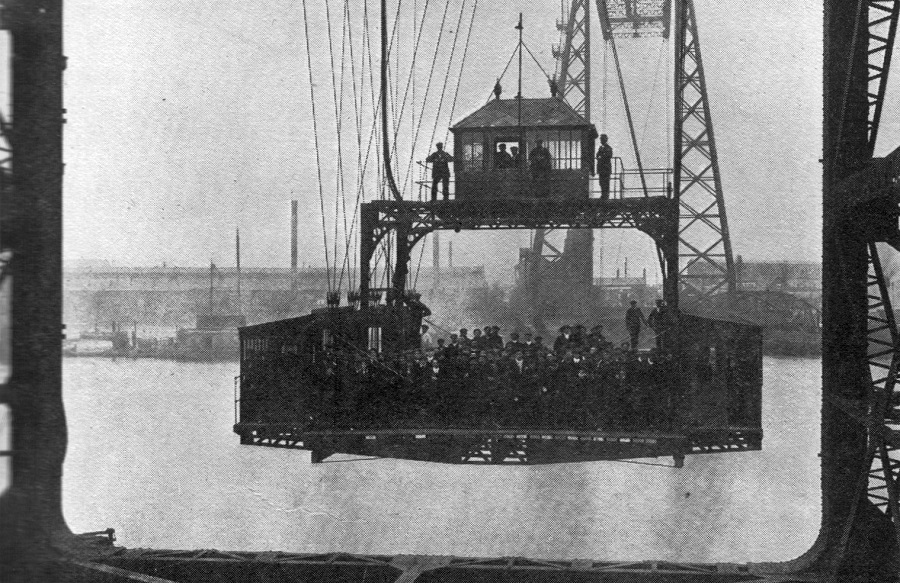
History of the Middlesbrough Transporter Bridge
During the 1800s, lots of people living in Middlesbrough worked for industries located in Port Clarence and had to make daily commutes across the river.
When Middlesbrough was a small town, people tended to use rowboats to cross the river but, as the Teesside iron and steel industries grew, so did the population and rowboats became a less viable option.
In 1862, a steam-powered ferry was brought into service. Needless to say, this made crossing the Tees less of a chore but the crossings were often difficult because of strong currents or the presence of other traffic on the river.
Initial Plans and Construction
In 1872, Charles Smith, who was the manager of the Hartlepool Ironworks, suggested introducing a form of aerial bridge ferry capable of carrying people across the river. His idea never saw fruition but the French bridge engineer Ferdinand Joseph Arnodin later developed the concept and, together with the Spanish engineer Martin Alberto Palacio, came up with a workable plan.
However, although Arnodin got to work building transporter bridges in other parts of the world, it was to be a long time before the people of Middlesbrough got one to help them get across the Tees.
Things began to get moving again in 1906 when Middlesbrough Corporation made contact with Arnodin and then reached out to William Edwin Pease.
Pease was the chairman/managing director of the Cleveland Bridge & Engineering Company in Darlington, which now trades under the name Cleveland Bridge.
In 1907, Parliament approved the construction of the Middlesbrough Transporter Bridge as an alternative to the ferry service. Cleveland Bridge handled the final design of the bridge and the construction work was contracted out to Sir William Arrol & Company of Glasgow.
Work on the foundations began in 1909 and the bridge was finally finished in September 1911. The Middlesbrough Transporter Bridge was officially opened on October 17, 2011, by Prince Arthur of Connaught. This was around 39 years after Charles Smith made his suggestion for an aerial bridge ferry.
The bridge was originally painted red but, in 1961, the colour was changed to blue. It has remained the same colour ever since.
Awards and Accolades
In June 1985, the Middlesbrough Transporter Bridge was made a Grade 2* listed structure. Buildings and structures only attain Grade 2* status if they are considered particularly important and worthy of special interest. The majority of listed buildings and structures in the UK (91.7%) are Grade 2. Only 5.8% are awarded Grade 2* status.
Then, in 1993, the Institution of Mechanical Engineers’ awarded the bridge the Heritage Plaque for engineering excellence.
The Transporter Bridge Receives Lottery Funding
In 2011, to the mark the Transporter Bridge’s centenary, the Heritage Lottery Fund provided a £2.6 million award to fund refurbishments and upgrades.
In 2013, the bridge closed, the refurbishment began in earnest, and a glass lift was installed as part of the Transporter Bridge Visitor Experience Project. The bridge was also treated to a new lick of paint.
The bridge remained closed until March 2015. The total cost of the refurbishment and upgrades was around £4 million. This exceeded the Heritage Lottery Fund award so Middlesbrough Council’s Local Transport Plan provided the additional money.
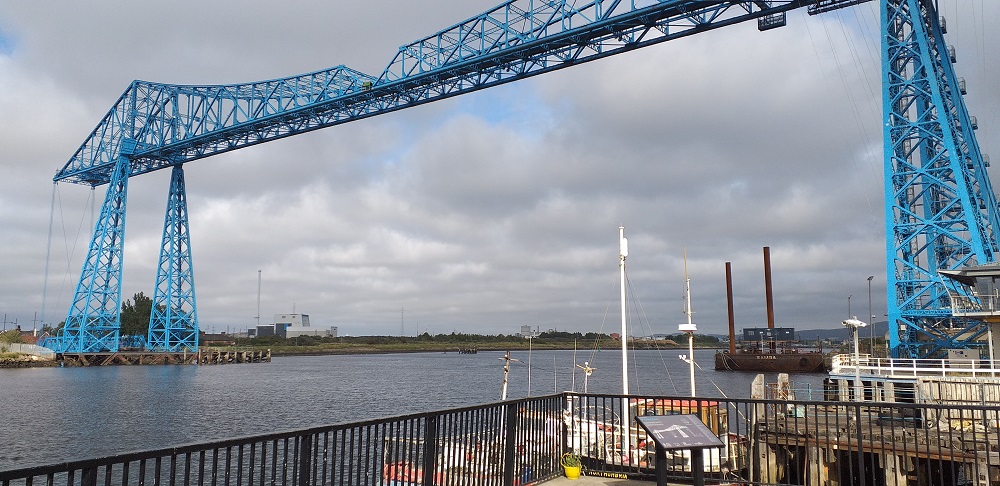
The Middlesbrough Transporter Bridge Visitor Experience
The new lift, which has been open since September 2015, is an important part of the visitor experience. The journey to the upper walkway only takes a couple of minutes but it’s a long way up (160 feet/49 m), so visitors who make the trip to the top need to have a good head for heights.
Up until the last few decades of the 20th century, people were able to use the steps on the transporter bridge legs (towers) to access the upper walkway and cross the Tees on foot. This is no longer the case.
Things have changed a lot at the top of the bridge. The original walkway was made of wood. This eventually rotted and was replaced with metal grating.
Grating was a good choice because it has a high load-bearing capacity, with a relatively low dead weight, and is a stable surface to walk upon. However, after the upper section of the bridge become open to visitors, the Transporter Bridge management wanted to make the visitor experience available to people with mobility issues. The metal grating was unsuitable for wheelchairs and walking sticks so it was replaced with fibreglass.
Wishing to provide a more family-orientated experience, the Transporter Bridge management asked health and safety officials if it would be permissible to take children to the top of the bridge.
The health and safety officials said it was too dangerous because children might be able to fall through the gaps in the railings at the side of the walkway. They suggested enclosing the entire walkway with metal mesh. This would have ruined the aesthetics of the bridge, so the proposal was unacceptable.
The Transporter Bridge management eventually reached a compromise. They fitted mesh to the side of the walkway and also raised the height of the two handrails that run parallel with the walkway.
The Middlesbrough Transporter Bridge visitor experience includes an escorted trip to the top of the bridge and visitors who wish to do so have the option of going hardcore by taking the stairs instead of the lift. Tours last for an hour and with a cost of £5.50 for adults and £4 for children, it’s a pretty cheap way to enjoy a truly unique experience and have the opportunity to see Teesside from one of the best vantage points in the area.
Visitors who wish to do so have the option of paying for a hard-hat audio tour. To make the experience even better and allow visitors to truly “capture the moment”, the hats have a video camera inside them.
Middlesbrough Transporter Bridge Opening Times
It’s normally possible to cross the Tees via the Transporter Bridge between the hours of 07:15 and 18:20. Depending on the time of day, the service generally runs constantly or every 15 minutes.
However, the opening hours are a little shorter on Saturdays and, on Sundays, there are no crossings at all.

The Middlesbrough Transporter Bridge Experience tour is normally available every day except Friday. If you need more information about times and availability, the best thing to do is call the Transporter Bridge and inquire.
Here’s the telephone number: 01642 727265
The bridge closes when there are high winds or other adverse weather conditions. So, if you are planning on making a crossing or contemplating a visitor experience and the weather is not good, it’s also a good idea to phone and check before you go.
| At the time of writing (August 2020), the Middlesbrough Transporter Bridge was closed for essential maintenance work. It will stay closed until at least March 2021. |
– – – – –
– – –
– – –
– – – – –
